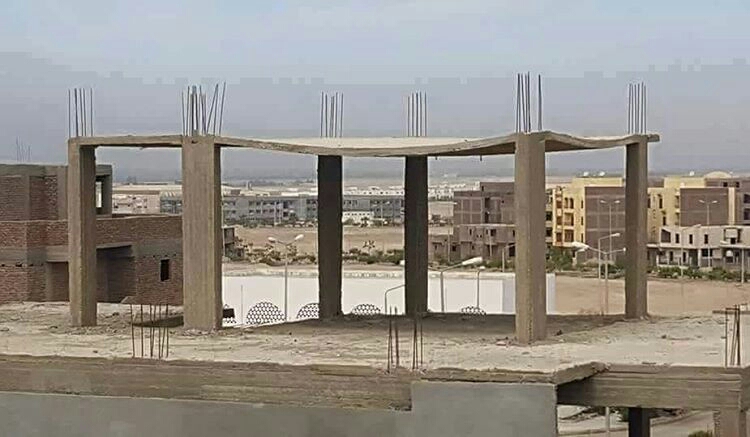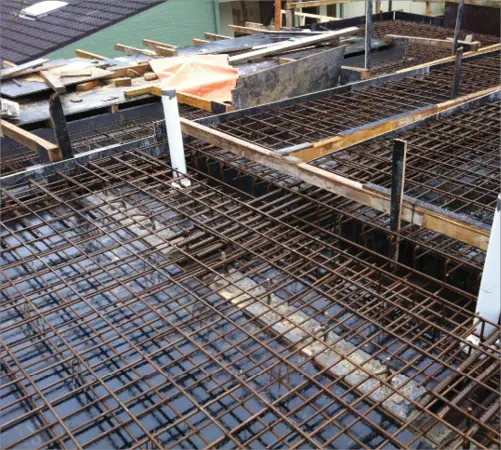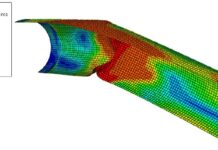A slab is a structural member whose depth is considerably smaller than the lateral dimensions. They provide useful surfaces for floors in buildings and support the occupancy loads. Reinforced concrete slabs may be supported by beams, columns, walls, or masonry. When a slab is supported on two opposite sides, they are referred to as one-way slabs because the load is transferred from the slab to the beam in the perpendicular direction.
However, if a slab is supported by beams on the four sides, and the ratio of length to width is greater than 2, majority of the load is transferred to the short direction to the supporting beams, and one-way action is obtained in effect, even though supports are provided on all sides.
The structural action of one-way slabs may be visualized in terms of the deflected surface. This can be approximated as a cylindrical surface, and curvatures and bending moments are parallel to the short side Lx. The slab is normally analysed a beam of a unit strip, with the bending moment, shear forces, and reinforcement determined per unit strip.
In many design circumstances, rectangular slabs have dimensions where the ratio of the longer side to the shorter side is less than 2 (and are also supported in such a way that two-way action results). When loaded, such slabs bend into a dished surface rather than a cylindrical one. This means that at any point the slab is curved in both principal directions, and since bending moments are proportional to curvatures, moments also exist in both directions.

To resist these moments, the slab must be reinforced in both directions, by at least two layers of bars perpendicular, respectively, to two pairs of edges. The slab must be designed to take a proportionate share of the load in each direction.
Why are Short Span Critical in Slabs?
Whenever civil engineering students enter a structural design classroom for the first time, they are told that the shorter span is more critical in the design of slabs. This is usually source of wonder for first timers because by mere instincts, the longer span should be more critical.
This article shows very simple proofs why the short span is more critical in slabs.
Deflection of centre-strip approach
This approach offers an extremely simplified concept that shows that the load transmitted to the shorter span is greater than the load transmitted to the longer span.
Let us consider the two way action of the slab shown below;
Looking at the centre-strips highlighted in red, a little consideration will show that at the intersection point of the strips, the deflection is equal. Logical right?
Let the uniform load on the longer strip be qy
Let the uniform load on the shorter strip be qx
We can therefore say that;
Deflection at centre w = 5qyLy4/384EI = 5qxLx4/384EI
5qyLy4/384EI = 5qxLx4/384EI
qyLy4 = qxLx4
We can verify from the above relationships that;
qx/qy = Ly4 / Lx4
Since Ly > Lx, we can accept that the load on the short span (qx) is greater than the load on the long span (qy) since Ly/Lx > 1.0
This is an oversimplification of the behaviour of slabs though.
Yield Line Approach
The yield line method was developed to determine the limit state of slabs by considering the yield lines that occur at the slab collapse mechanism. The yield lines are usually approximated to originate at the corners, forming at an angle of 45° until they intersect. These yield lines usually show trapezoidal loads going to the longer supporting beam of the slab, and triangular loads going to the shorter supporting beam.
Let us assume that the slab is subjected to a unit pressure load (1 kN/m2)
Ly = 6m
Lx = 5m
Area of trapezium = 8.6825 m2
Area of triangle = 6.316 m2
Therefore;
The load parallel to the short span (Px) = 2 × 8.6825m2 × 1 kN/m2 = 17.365 kN
The load parallel to the long span (Py) = 2 × 6.316m2 × 1 kN/m2 = 12.632 kN
Total load on slab = (5 × 6)m2 × 1 kN/m2 = 30 kN
Therefore, you can see why the shorter span is more heavily loaded based on the yield line pattern.
Finite Element Analysis
When we carry out finite element analysis on slabs, the result offers an insight;
Let us check out the slab investigated above using finite element analysis results from Staad Pro.
Let us assume that the slab is subjected to a unit pressure load (1 kN/m2)
Ly = 6m
Lx = 5m
Thickness of slab = 150 mm
v = 0.2
E = 21.7 kN/mm2
From the result, the bending moment parallel to the short span is given below;
In the longer direction;
If you look at the results above, the moments parallel to the the short span is more critical than the moment parallel to the longer side.
Conclusion
The load transferred to supporting beams through the short span of the slab is heavier than the load transferred through the long span of the slab. For a one way slab, the slab is analysed as a beam of unit width , and the main reinforcement is provided parallel to the short span, while distribution bars are provided parallel to the long span. Minimum steel can be used as distribution bars.
But for two way slabs, the slab is designed for strength in the two principal directions, but the main bars are placed at the bottom, parallel to the short span, while the other is placed near to the bottom (on top of the bottom bar) parallel to the long span











Impressive, Can i Share your Article in my Case Study Page?
Simple and well detailed review of the topic. If only teachers of the subject are well grounded like u. Keep the zeal unquenched.
This is amazing, I'm a student yet to be thought this. I guess I have an edge already.
Thank you very much
Provided you maintain the original link of the source. You can share
I am glad you found this article helpful. Thanks
Well detailed just like professor Aginam.
I really want to understand the concept of double reinforcement pls
Even a none engineering student will understand this principle when he reads this article… You are highly loaded boss… Thank God for you!!!!
Ranks am a structural engineer,just my Master's. Your information's are among the best .i always consult your page regularly. Keep it up bro. Happy Sunday
very helful
Well done bro. You did justice to this concept
Well explained.Great work done, congratulation.